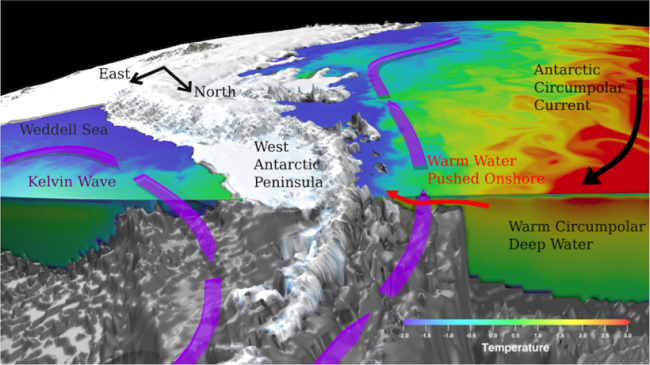Coastal waves drive Antarctic ocean warming
Ocean melting of marine-terminating ice sheets poses a profound threat to the global coastal environment with approximately five meters of sea level rise locked up in the ice sheets around the West Antarctic region. Recent observations suggest significant ocean warming is already underway in this region, yet we have little understanding of the underlying processes. A new study published in Nature Climate Change tries to understand why the warming of Antarctic coastal waters is largest west of the Antarctic Peninsula and demonstrates how this warming can be caused by changes in distant Antarctic coastal winds.

The findings reveal how a drop in sea level initiated by changing East Antarctic coastal winds is propagated around the Antarctic coastline at nearly 700 km/hr. The sea level anomaly creates an along-shelf geostrophic coastal current anomaly, which is particularly strong on the western side of the Peninsula. Due to both bottom-boundary layer friction and interior adjustment, this coastal current anomaly facilitates the movement of warmer deep water upward onto the continental shelf and toward the coast (see Figure).
The subsurface warming develops a focused intensity on the western side of the Antarctic Peninsula, 6,000 km away from the western edge of the wind perturbation. After 90 days, the Antarctic Peninsula anomaly can locally exceed 0.5°C, and within a few years can explain the observed warming trends at the base of the ice shelves in the Amundsen and Bellingshausen seas.
The researchers think the warming is largest on the western side of the Peninsula for two main reasons. First, the Antarctic Circumpolar Current brings warm salty water close to the continental shelf. Second, the influence of the coastal waves is strongest on the western side of the peninsula, due to topographic steering by the particularly steep shelf edge bathymetry.
Overall, this study reveals a unique susceptibility of the Antarctic coastal ocean to remote wind perturbations, particularly subsurface ocean temperatures on the western side of the peninsula. The East Antarctic wind perturbation considered was motivated by the projected influence of the Southern Annular Mode (SAM). However, Antarctic coastal wind disturbances are not unique to the SAM or East Antarctica. Other links between climate modes of variability and Antarctic coastal winds can produce a similar coastal wave ocean response.
Localized rapid warming of West Antarctic subsurface waters by remote winds (Nature Climate Change)
1University of New South Wales, Sydney, Australia
2Australian National University, Canberra, Australia
3NOAA Geophysical Fluid Dynamics Laboratory
Topics
- Sea Level Rise
- Southern Ocean
- Ocean Heat
- Climate Change
- Antarctica
